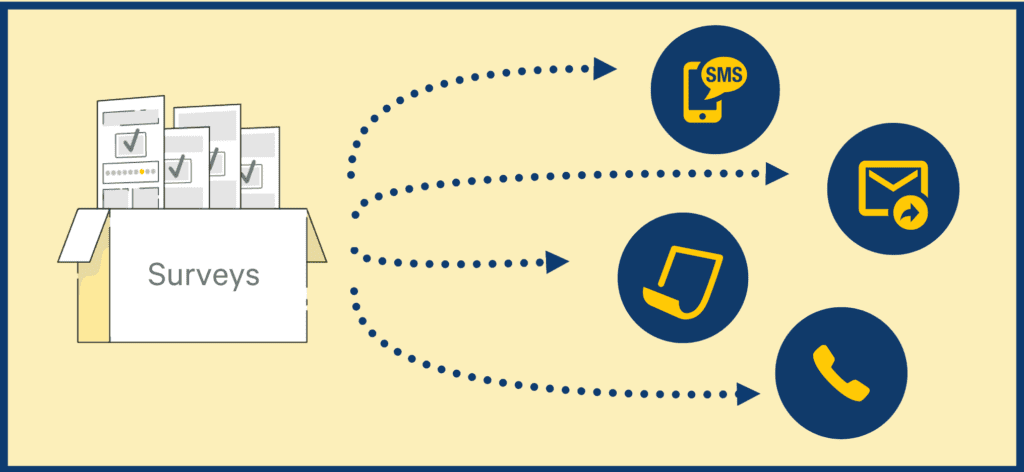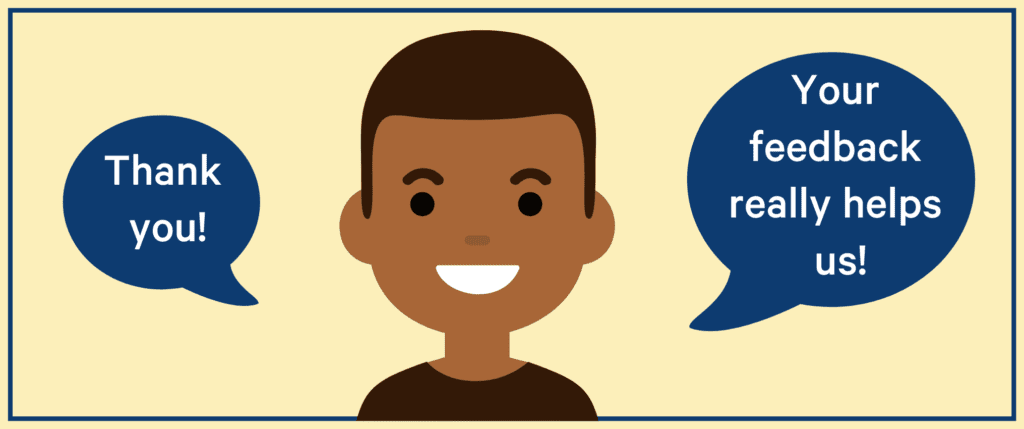Average Survey Response Rate – Finally Revealed


Have you ever wondered what the average survey response rate is? Well, wonder no more! The answer is finally revealed in this article.
We will touch on the following:
- How to define and calculate the survey response rate
- How it's different from the completion rate
- What factors affect it
- How you can increase it
- And how we can help you out
So buckle in, and let's get started!
Survey Response Rate Defined
Whether you're looking to assess client satisfaction with your company, what consumers may think about a new product you're creating, or even employee happiness and engagement, conducting surveys is a great way to collect this valuable data.
To find ideas, find problems. To find problems, talk to people. -Julie Zhuo, former VP Design at Facebook.
However, it's not enough to simply send out questionnaires– the survey responses need to be there so you may actually get the answers to the questions.
The survey response rate is the factor that tells you how many responses you got. To calculate it, you need to divide the number of people who respond to your survey by the total number of people you invited to partake in them.
For example, if you send out 100 surveys and 50 people respond, your survey response rate would be 50%.
Yes, but why is it important?
Importance of Survey Response Rate
Let's assume that you've put a lot of time and effort into creating your survey.
You've come up with the perfect list of questions, found an expert to help you design and execute it, and sent it out to your target audience.
But then, you find out that only 10% of people respond to your survey.
What happened? Was the survey not optimized, or was it too long?
Several factors affect why you might not be getting the survey responses you are hoping for, and we will touch on them going forward. Right now, the critical question is, what does low response rates mean?
A low response rate introduces all sorts of bias into your data, which means that it's no longer accurate. That, in turn, skews your results and may lead you to make wrong decisions based on inaccurate information.
For example, let's say you're trying to assess employee satisfaction at your company.
You send out a survey to all employees, and only 10% respond. Regardless of the survey result, you won't have a grasp on the bigger picture because 90% of your employees didn't respond. And that could lead you to make changes that end up being more harmful than helpful.
On the other hand, if you have a high or good survey response rate, you can be more confident in the accuracy of your data. This is because you will have heard from a larger sample size of people, which means that the results are more representative of the entire population.
Now that we have covered the definition, calculation, and importance of survey response rates, let's look at the difference between responding to a survey and a completed survey.
Response Rate Vs. Completion Rate: Are They the Same Thing?
Although it may seem that the survey response rate and the survey completion rate are the same, they actually differ in one key aspect.
The survey response rate is the number of people who start the survey divided by the total number of people you invite.
On the other hand, the survey completion rate is the number of people who finish the survey divided by the total number of people who started it.
For example, you send out 100 surveys, and 50 people start filling them out. But of those 50 people, only 40 people finish it. In this case, your survey response rate would be 50%, but your survey completion rate would be 80%.
As you can see, the survey completion rate will always be lower than the survey response rate.
That can happen due to various reasons
- The survey is too long
- The questions are misleading or too difficult
- Not interested in the topic
- Boredom
Let's look at a few factors that can affect how people respond and move to complete your surveys.
Survey Response Rates Are Affected By…
These factors are not listed in any particular order. You might find that some of them affect your business more than others.
Survey Design

The survey design incorporates various things like:
- The overall look and feel of the survey
- How easy it is to understand
- How long does it take to complete
If you want a good survey response rate, it's essential to ensure that they are well-designed.
You should also make sure that the questions are relevant to the topic. Furthermore, the survey title should be catchy and clearly shows what the survey is about.
The tone of the survey is important, too.
If the survey is too formal, people may feel like they are being interrogated, and you might see survey response rates decreasing. On the other hand, if the survey is too informal, people may not take it seriously.
You can strike a balance by using a helpful and friendly tone. That will help increase survey responses as people will be more likely to answer your questions.
Target Audience
Another factor that can affect survey response rates is the target audience. If you are targeting a B2C audience, you may find that the response rate is lower than if you were targeting a B2B audience.
This is because people are generally more likely to respond to surveys that are relevant to their work. Furthermore, you should also note that external surveys often have lower response rates (around 20%) than internal ones. Therefore, if you want to target a B2C audience, it's vital to make sure that the survey is relevant to their interests.
The demographic you target will also help determine whether the response rate will be high or not. You may find that some age groups and population segments are much more likely to engage with the survey than others.
Timing

The timing also plays a crucial role in determining your survey response rates.
If you send out a survey too soon after someone has made a purchase, they may not be ready to give feedback yet. In contrast, if you wait too long, they may have already forgotten about their experience.
The best time to send out a survey is generally around a week after the purchase has been made. This will give survey respondents enough time to use the product or service and form an opinion about it.
Distribution Channel

The distribution channel is how you send out the survey. Every channel has its benefits and drawbacks. You can use email, social media, in-person, and more.
An email survey might have a higher response rate than a survey conducted in-app. However, the latter might have a lower response rate but a higher completion rate.
Hence, it's vital to consider both; the response rate and the completion rate when deciding on the distribution channel.
Hopefully, now you are aware of a couple of different factors that can affect how many people respond to your surveys.
Now the question becomes, how can you increase your average response rate?
How to Increase Average Survey Response Rates
A good survey response rate helps you make better decisions, and there are various ways you can increase it.
Here are some tips:
- Keep surveys short and sweet
- Use survey logic and branching
- Make the respondents feel acknowledged
- Send surveys at the right time
- Use the right distribution channel
Keep Surveys Short and Sweet
You can increase survey response rates by keeping the questions short and sweet.
If people feel like the survey will take too long, they are less likely to want to take it. No one wants to see a long questionnaire with rows and rows of tick-the-box style questions.
One way of doing this is by only asking questions that are relevant to the topic at hand. Another way is by using multiple-choice questions or Likert-scale questions instead of open-ended ones.
This will make the survey quicker to fill out, and more people will be likely to complete it. Furthermore, seeing an easy-to-answer survey increases response rates.
Survey Logic and Branching
You can increase online survey response rates with logic and branching.
That is because survey logic and branching allow you to customize the questions according to the answers. Thus, people feel that their time is being used efficiently.
With survey logic and branching, people are only asked questions that are relevant to them. This personalized attention engages people and makes them want to take surveys.
Make the Respondents Feel Acknowledged
When conducting a survey, it's important to make the respondents feel appreciated. You can do that by sending a thank-you message after they have completed the survey. This shows that you value their time and feedback.

Once customers know that their opinion is sought, they will actively look for the next opportunity to partake in your survey.
Another way of making respondents feel appreciated is by offering an incentive for taking the survey. That could be in the form of a discount coupon or a free product.
Ensure that the incentive is valuable enough to make people want to take the survey but not so valuable that it skews the results.
Send Surveys at the Right Time
As mentioned earlier, timing can help make or break your survey response rates.
You need to send the survey when people are most likely to respond.
For example, you want employee feedback on the recent change of the coffee machine. Surveying employees immediately might lead to lower response rates because they haven't had enough time to form an opinion. It might also lead to a higher response rate but with mostly negative feedback.
A better time to survey would be a week or two after the change; people will get used to the new machine and form a more accurate opinion.
However, giving too much time might result in losing honest, top-of-the-head answers and introduce bias in the data.
Use the Right Distribution Channel
The final tip for increasing survey response rates is to use the right distribution channel.
One of the most common ways of distributing surveys is via email. However, this might not always be the best option. For example, if you're surveying people who don't use email often, then you're not going to get good response rates.
It's essential to think about who you're surveying and how they can be best reached.
Other options for distributing surveys include social media, postcards, and in-person. The following graph helps you see the acceptable survey response rate for some common distribution channels.
Speaking of the average and acceptable survey response rate, let's see how Trustmary performs compared to industry standards.
Average Survey Response Rates with Trustmary
The variation in response rate ranges from 5 to 50%. With Trustmary, the average response rate for B2B is somewhere around 33%. Furthermore, anything above 20% is quite good for NPS surveys.
Trustmary is a SaaS tool that helps collect and utilize testimonials. Furthermore, it is one of the best software for measuring customer satisfaction, collecting feedback, and setting up new lead generation forms.
With Trustmary, the typical survey response rates will be somewhere around 30%, which, as shown earlier, is quite good.
How do we do that?
Well, Trustmary allows you to automate the entire process of sending surveys. Furthermore, you can add personalized reminder messages to increase engagement, set wait times, and share the forms via various channels.
Let's go into little detail about automating and being systematic with surveys.
Benefits of Being Systematic with Surveys
Automating and repeatedly collecting feedback allows you to get vital data about the consumers throughout their customer journey without much hassle. Furthermore, by surveying everyone systematically and often enough, you slowly understand what your customer base really thinks about you.
Being systematic with surveys helps you track customer satisfaction over time. You can identify any changes in customer sentiment and take corrective action if necessary.
Moreover, surveying customers regularly shows that you care about their opinion and helps you build a relationship of trust with them. It is one of the foundations for making your brand more customer-centric.
By having a tool like Trustmary, you can do this easily and efficiently.
Trustmary can be integrated with most CRM systems like Pipedrive and Hubspot.
The following flowchart is an example of a simple automation process that allows you to reach customers on various channels, thus, increasing response rates.
Integrating Trustmary with your CRM systems is a piece of cake, and the whole process can be automated with just a few clicks.
For a quick recap, we have learned that Trustmary can:
- Fully automate the process of sending out surveys
- Increase engagement and response rates
- Set wait times and send reminder messages
- Share forms via various channels
So what are you waiting for? Book a meeting today and create appealing surveys that encourage high response rates with Trustmary today!
FAQ
What is the average survey response rate?
The average response rate across all channels is around 33%.
That varies largely depending on the type of survey, the channel used, the length of the survey, etc.
Depending on the business, retention rates, and other factors, response rates vary from 5 to 50%.
Why is my survey response rate so low?
There is usually not one reason why your response rate might be low. Some common reasons include:
- The survey is too long
- The survey is not mobile-friendly
- People are not aware of the
- There is no incentive to complete the survey
How can I increase my survey response rate?
There are several ways to enhance your survey response rate. The following are a few ideas:
- Make sure the survey is short, sweet, and to the point
- Use an engaging design that doesn't look like a traditional survey
- Incentivize people to take the survey
- Use mobile-friendly design and make sure the survey can be taken on a mobile device
- Make sure people are aware of the survey and how to access it